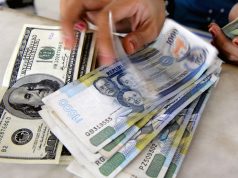Inflation expected to have eased further in June
THE general year-on-year rise in prices of widely used goods and services likely eased further in June from May due to lower fuel and electricity costs, the Bangko Sentral ng Pilipinas (BSP) announced on Friday.
“The BSP forecast suggests that June inflation could settle within the 2.4-3.2% range,” BSP Governor Amando M. Tetangco, Jr., who ends two successive six-year terms on July 2, told reporters in a mobile phone message.
That range compares to May’s actual 3.1% and would still be faster than June 2016’s 1.9%.
The estimate range falls within the central bank’s 2-4% target band for the entire 2017, with the lower estimate bringing the six-month average to 3.05% and the ceiling taking it to 3.18% against an official forecast average of 3.1% for the whole year.
“The decline in domestic fuel prices and lower electricity rates in Meralco-serviced areas could lead to lower price pressures for the month,” Mr. Tetangco said.
The Manila Electric Co. — the country’s biggest electricity distributor that serves the country’s capital and surrounding areas that cumulatively contribute more than a third to national output — cut its basic tariff for a second straight month in June, by P1.43 per kilowatt-hour (/kWh) to P8.17/kWh, “the second lowest since December 2009”.
Electricity alone contributes 4.51% to the consumer price index (CPI) — the theoretical basket of goods and services consumed by a typical Filipino household that, in turn, is used to compute general year-on-year price increases.
Fuel pump prices also went down from May. Energy department data showed gasoline prices going down to P41.50-45.25 per liter as of June 21 from P43.55-47.30 per liter as of May 31, diesel price easing to P28.85 per liter from P31.40 per liter and kerosene slipping to P35.45 per liter from P37.70 per liter in the same comparable periods.
The commodity group housing, water, electricity, gas and other fuels accounts for 22.46% of CPI, the second-biggest contribution next to food and non-alcoholic beverages’ 38.98%.
The Philippine Statistics Authority is scheduled to report June inflation data on July 5.
Inflation is a key indicator the central bank watches as it calibrates policy. Mr. Tetangco’s last policy meeting last June 22 saw the BSP’s Monetary Board maintaining the overnight lending rate at 3.5%, the overnight reverse repurchase rate at three percent and the overnight deposit rate at 2.5%. Reserve requirement ratios imposed on banks were also retained.
The BSP has kept policy rates steady since a rate hike in September 2014, save for procedural cuts in June last year as the central bank migrated to an interest rate corridor scheme that employs weekly term deposit auctions to better siphon excess liquidity and influence market rates.
Deputy Governor Nestor A. Espenilla, Jr., succeeds Mr. Tetangco on July 3.
“Moving forward, the BSP will continue to monitor evolving price conditions and adjust policy setting appropriately to ensure price stability conducive to balanced and sustained economic growth.”
Philippine gross domestic product grew by a slower-than-expected 6.4% in the first quarter — against a 6.5-7.5% official full-year target — but it was still the second-fastest clip among comparable major Asian economies next only to China.



